If you’ve been told it’s impossible to outperform low-cost index funds because the market’s too efficient, you’ve been lied to.
The truth is, there many funds out there that have been beating the broader stock market for years. And here’s something really surprising: there are more funds pulling off this feat now than there have been in a long time!
In fact, across ETFs, mutual funds, and closed-end funds (CEFs), there are 7,643 funds that have beaten the S&P 500’s 7.62% return over the past year.
So much for not beating the market!
Besides the fact that not choosing the low-fee passive fund will get you superior returns, you might be also be surprised by one other fact I just threw out there: a 7.62% return for stocks in general over the past year.
“But isn’t the stock market crashing?” you might say.
Well, not really; while we’re 6.7% off the market’s all-time high, reached a couple months ago, stocks have indeed gone up by that much over the last year:
A Totally Normal Year for Stocks
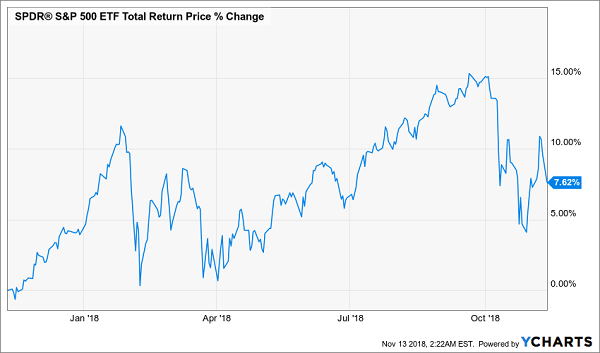
What’s more incredible is that the stock market’s long-term average return is about 7.5%, so this is pretty much in line with what you should expect from the market over the long haul.
Again, if this isn’t the message you’ve gotten from the mainstream financial press, you’re not getting the real truth.
So if stocks remain a solid bet for long-term gains, despite short-term volatility, does that mean it’s time to throw your money into the market?
The answer is yes, especially now. Because after the market’s recent selloff, it’s gone from an abnormally high short-term return to a more normal one, meaning you’re getting stocks much cheaper than if you threw your money in when the market was so euphoric.
Welcome to the world of contrarian investing.
Here’s an example of how timing can work for (and against) you: let’s say you bought the Invesco QQQ Trust (QQQ), an index fund that tracks the Nasdaq 100, in December 2015 and held until now—nearly a 3-year period. You’d have gotten a nice 38.8% return over that time, or a profit of about 13% per year:
13% Annualized Gains Are Nice …
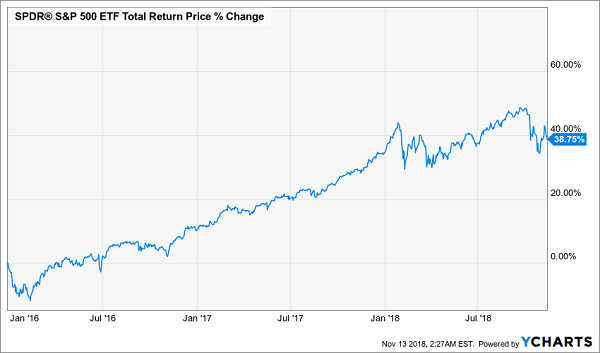
But if you waited until the silly market panic of February 2016, your gains would be a whopping 54.2%—or a return of over 18% per year:
… But 18%+ Annualized Gains are Nicer!
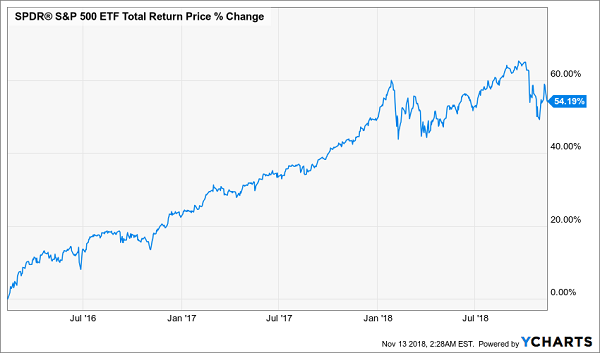
There is just one snag with QQQ: the income is lousy. With a measly 0.79% dividend, QQQ is hardly the kind of fund you can retire on. And while you could buy and then sell when the market gets overhyped and use your gains for income, that’s tough to do: not only will you have to time the market by analyzing the technical and fundamental movements of the companies QQQ holds, you’ll also have to have the fortitude to sell when the market is euphoric, which is almost as hard as buying when the market is panicking!
Fortunately, there’s a better way.
There are a few tech funds out there managed by people with decades of experience who will do this work for you, all the while giving out regular dividends.
Closed-end funds are well regarded for their ability to do this, giving you a convenient way to cash in on the market’s average 7.5%-ish return with a steady income stream.
So instead of buying QQQ and stressing, you can buy the BlackRock Science & Technology Trust (BST) instead. This fund’s 6.4% dividend isn’t only secure, it’s been going up, making it a rare high-dividend and dividend-growth fund:
Payouts on the Rise
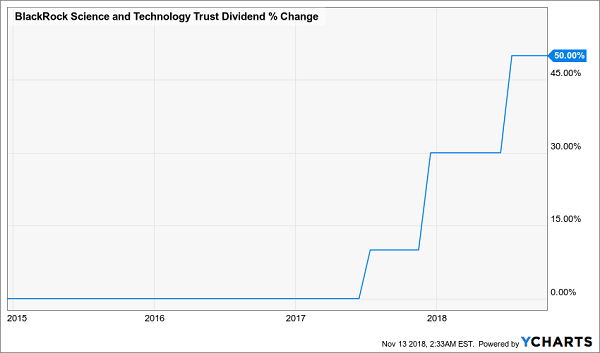
How is BST able to raise payouts? Simply put, its dividend yield is far below its average return. Since QQQ has gone up double digits per year, on average, for over a decade, BST has easily been able to match that return and more than cover its 6.4% dividends, since it invests in the same stocks that comprise QQQ.
But what makes BST even better is that it’s been crushing the index for a long time—since inception, in fact:
BST Tops the “Dumb” Index Fund
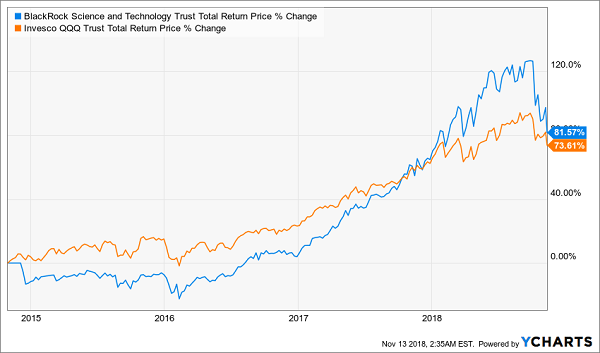
That has also attracted investor interest, causing the fund’s discount to net asset value (NAV, or the market value of its underlying portfolio) to turn into a premium earlier this year—but that premium has recently halved with the market’s volatility:
Premium Performance Attracts … a Premium
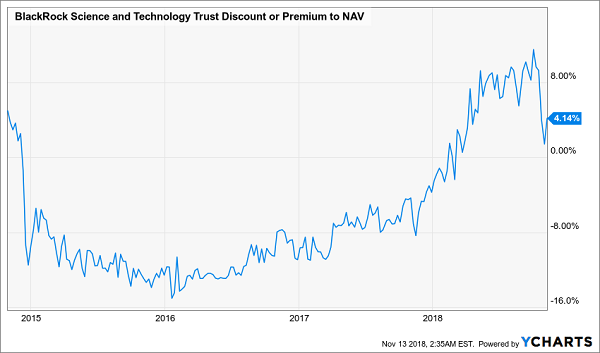
In almost all cases, I recommend investors buy CEFs when they trade at a discount. But I would make an exception for BST, thanks to its stellar track record, which is getting better. While QQQ is up less than 10% over the last year, BST is up 14%:
Crushing the Market
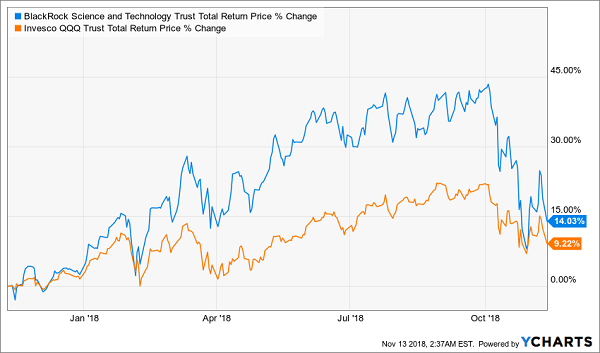
Also, note how the tech sector is still beating the broader market (remember, the S&P 500 is up 7.6% over the last year).
That might come as a surprise if you’ve read headlines about a bloodbath in the tech space. While there has been a big correction lately, tech is still leading the pack. And with strong earnings from the sector so far in 2018, expect investors to realize that the tech correction is overblown, causing both QQQ and BST to soar.
BST Will Soar in 2019—But These 8%+ Dividends Are Even Better Buys
In fact, in 2019, I expect BST’s upside to be magnified by a double-digit surge in the market as a whole.
How do I know? Because of one of the most consistent indicators there is: the 4-year presidential-election cycle.
And guess what: year 3 is the most profitable of them all! Going back to 1928, its average gain is an eye-popping 12.8%:
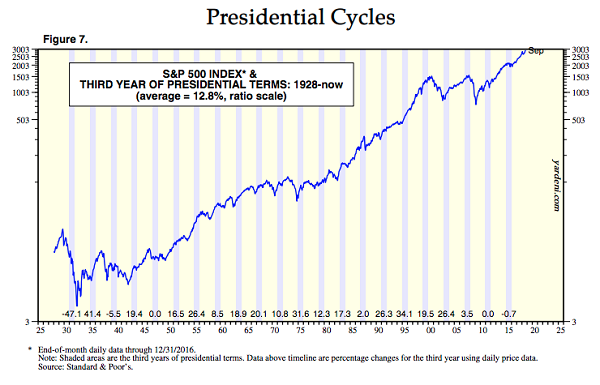
Source: Yardeni Research
And that 12.8% spike is just the average. In some years, the market has gone even higher than that!
The best way to tap into these gains? CEFs, of course!
BST is just the start: I’ve got 5 more hand-picked CEF buys for you, throwing off an even higher dividend than this tech standout pays—8% on average—right now.
Each of these funds is also a lot cheaper than BST, boasting outrageous discounts to NAV that just can’t last. As these totally unusual markdowns slam shut, I fully expect each of these funds to propel us to at least 20%+ price upside.
Add in their outsized 8%+ dividends, and you’re looking at a 28%+ windfall here!
But you must act now. These 5 buys are already starting to tick higher, and I don’t want you to miss your chance. Click here to get full details on all 5 of these cash machines—names, tickers, buy-under prices and everything you need to know to kick-start your 8% cash stream today.

Recent Comments